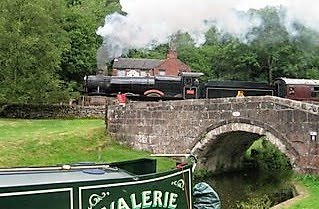This is Stockers lock and the house, built for the collector of coal duties entering London by canal. The Great Fire of London in 1666 brought about a duty imposed by the Corporation of London on coal entering the capital. The duties were to finance the re-building of St. Paul's Cathedral, other London churches and public buildings plus Newgate prison. Of course the canal wasn`t around then and coal--known as `seacoal` came into London by ship.
The duty in 1667 was a shilling per chaldron. A chaldron was not a weight but a measurement used for coal (try a Google search). Its size varied from district to district because this helped merchants save duties; but from what I`ve read was about 25cwt or one and a quarter tons.
So for our U.S. readers and those born post decimal, the duty was 5 pence (8 cents) per ton and a quarter (1524kilos). Looking up that kilo conversion I found long, short, and metric tons. I used the former.
I am well confused here as my childhood school days taught me 112 lbs. = 1cwt. and 20cwt.= 1 ton or 2240lbs. I think my confusion is to do with long and short tons, and just like the blog post I did from the states on the cost of petrol and I got it wrong, this could all end up the same way.
Now if I had married an English girl the last few lines wouldn't have been needed but as love wins over everything you can just work it out for yourselves.
Anyway back to the story of the coal duties. The 1667 act also allowed for the building of the `The London Monument` commemorating the Great Fire of London. In 1670 the duty tripled. The area affected by the duty stretched out to a radius of about 25 miles and included coal entering the London limits by any means.
In 1793 the act of Parliament for the Grand Junction canal included the restriction, following protests by sea companies, that coal would not be brought closer to London than Langlebury just north of Watford.
Langlebury was to be the route of the canal to avoid the Grove and Cassiobury parks owned by the Earls of Clarendon and Essex who were none too keen on allowing the canal through their property. Money changed hands and the canal route also changed--back to the canal company's' preferred route through the parks. Lady Capel's Wharf within Grove Park became a busy depot as coal was unloaded onto carts for delivery in the area. In years to come the railway company were refused the same access across the parks and Cashio tunnel led the rails into Watford. I guess the name Cassio as in lock and bridge came from Cashio.
Parliamentry acts from 1805 and later allowed for 50,000 tons of coal to enter London subject to the duties being paid. The railway companies were allowed 500 tons duty free for use in their locomotives in the London area.

In 1861 the boundry for the coal duty changed to the Metropolitan Police district and Stockers house was built just a few hundred yards inside the boundary for the collector of the coal duties coming in by canal.
The boundary was marked by stone or cast iron posts as in the one at Stockers lock, pictured at right.
In 1869 so little coal was actually entering London due to railway competition, the canal companies made their own payments and Stockers house was sold. Duties were paid weekly by the rail companies and monthly by canal carriers. The coal duty collector for the Corporation of London finished his time at Bushey, a busy rail link to London, and in 1889 coal duties stopped.
Links; HERE
HERE
HERE



No comments:
Post a Comment